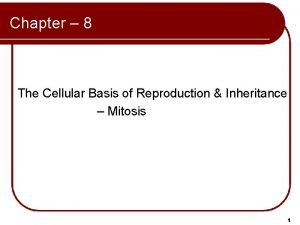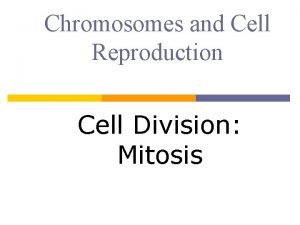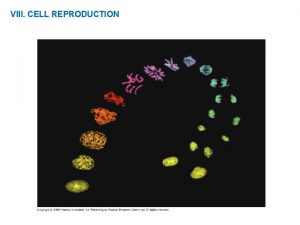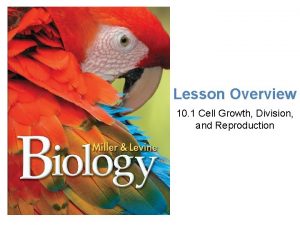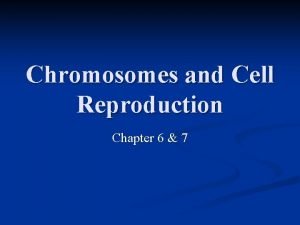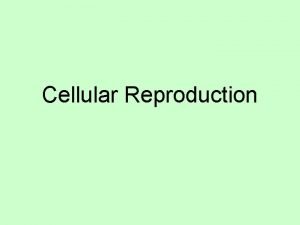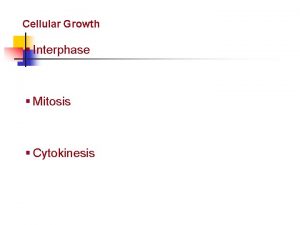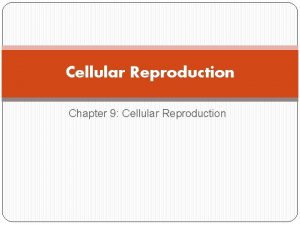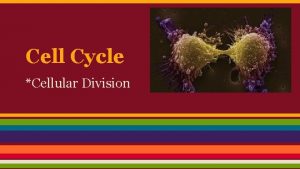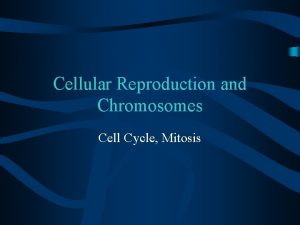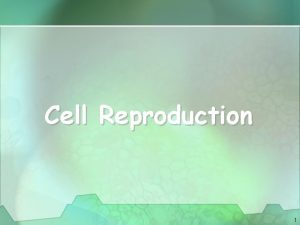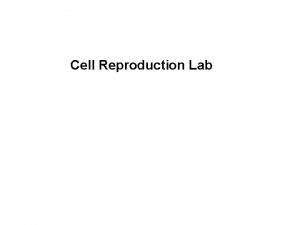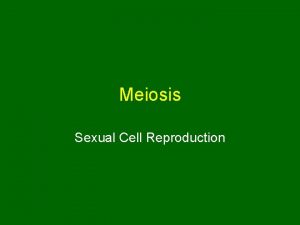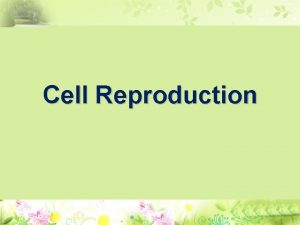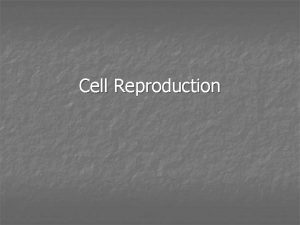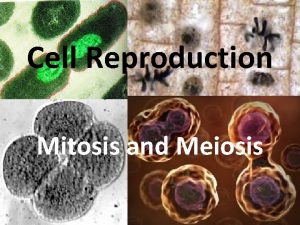Unit 2 Reproduction Development Cellular Reproduction The cell


















- Slides: 18

Unit 2: Reproduction & Development Cellular Reproduction The cell cycle Cell growth Cell division

Why do cells have to reproduce? • Cells must continuously reproduce to repair damaged tissues & replace lost cells • During the initial development: cell reproduction is important for the growth of the organism & production of different types of cells (differentiation)

How do cells reproduce? • Continual cycle of growth & division: cell cycle • Growth stage is called: interphase • Division stage is called: mitosis

Interphase • Majority of the cell cycle • Growth stage – cell produces new molecules which increase the volume & mass of the cell • DNA replication takes place • 3 stages of interphase: G 1, S, & G 2 • If a cell does not divide, it can stay in G 1 for a rest period

3 stages: 1. Cell growth (phase G 1) 2. DNA replication (S phase – synthesis) 3. Cell prepares itself to divide (phase G 2)

2 Checkpoints during Interphase • At the end of G 1 – cell will not continue to S phase if: ▫ ▫ Cell is not big enough Unfavourable environment DNA is damaged Other problems. . . • At the end of G 2 – cell will not continue to mitosis if: ▫ Cell is not big enough ▫ All of the DNA has not replicated http: //www. cellsalive. com/cell_cycle. htm

So, why do cells divide instead of simply growing larger & larger? • Cell will not be able to take in enough nutrients • Surplus of wastes • Cells die – new ones have to be produced

Mitosis • Part of the cell cycle where the nucleus is divided into 2 • Daughter cells receive the same number of chromosomes & the same genetic material as the parent cell • Therefore: mitosis creates two identical cells • Mitosis takes place in almost all body cells

Mitosis events: 1. Replication of genetic material in the parent cell 2. Separation of the replicated material 3. Formation of two daughter cells

Before we talk about mitosis. . . • • • Chromosome: Chromatin: Sister chromatids: Centromere: Haploid: Diploid:

Stages of mitosis: • • prophase metaphase anaphase telophase ▫ cytokinesis http: //www. cellsalive. com/mitosis. htm

Prophase • During this stage, chromatin (DNA & proteins) condenses, thickens & forms X-shaped chromosomes • Each chromosome was duplicated already during interphase • Nuclear membrane & nucleolus break down & disappear • The centrioles migrate towards the opposite poles • Spindle fibres (microtubules) start to form between the centrioles

Metaphase • Spindle fibres attach to the centromeres • Guide the chromatids to the centre of the cell – equatorial plate • One of the chromatids is attached to a fibre at one pole, the other is attached to the opposite pole

Anaphase • Centromeres split & the chromatids are pulled towards the opposite poles by the shortening of the spindle fibres

Telophase • Chromatids are separated to either pole & are referred to as individual chromosomes now • Nuclear membrane starts to reform around the groups of chromosomes • Nucleolus reforms • Spindle fibres disappear

Cytokinesis • Part of telophase • Division of the cytoplasm into 2 new cells • Animal cells: cell membrane is the last structure to form • Plant cells: cell wall forms & separates the 2 new nuclei

Can cells continue to divide perpetually? • Cells have a “biological clock” ▫ Different types of cells have different limits on the number of times that they are able to divide ▫ “Old” cells have undergone many divisions • Specialization decreases a cell’s ability to reproduce ▫ Skin cells – less specialized – can continue to divide ▫ Muscle cells – more specialized – reproduce less often

Perpetual division • Two types of cells are able to divide “endlessly” ▫ Spermatocytes – produce sperm ▫ Cancer cells – reproduce quickly, form tumours �Quick reproduction prevents the cells from specializing & carrying out normal functions
 Chapter 9 cellular reproduction
Chapter 9 cellular reproduction Chapter 9 section 1 cellular growth
Chapter 9 section 1 cellular growth The cellular basis of reproduction and inheritance
The cellular basis of reproduction and inheritance Chapter 9 cellular reproduction
Chapter 9 cellular reproduction Chapter 8 cellular reproduction cells from cells
Chapter 8 cellular reproduction cells from cells Sexual reproduction vs asexual reproduction venn diagram
Sexual reproduction vs asexual reproduction venn diagram Asexualk
Asexualk Venn diagram of sexual and asexual reproduction in animals
Venn diagram of sexual and asexual reproduction in animals Cellular transport and the cell cycle
Cellular transport and the cell cycle All cells must contain
All cells must contain Where in the cell does cellular respiration occur
Where in the cell does cellular respiration occur Cellular respiration formula
Cellular respiration formula Cell reproduction
Cell reproduction Mitosis sexual reproduction
Mitosis sexual reproduction Cell cycle and replication
Cell cycle and replication Cell reproduction
Cell reproduction Cell growth division and reproduction
Cell growth division and reproduction Chapter 6 chromosomes and cell reproduction
Chapter 6 chromosomes and cell reproduction Unit 6 review questions
Unit 6 review questions


